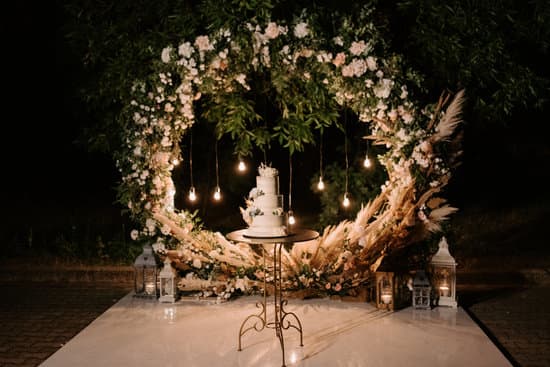Addressing a married couple on a wedding invite may seem like a small detail, but it holds significant importance in setting the tone for the event and showing respect to the recipients. Whether following traditional etiquette or opting for a more modern approach, finding the right way to address a married couple can make all the difference in conveying thoughtfulness and consideration.
In this article, we will delve into the various aspects of addressing married couples on wedding invitations, from traditional guidelines to modern alternatives, as well as addressing children and LGBTQ+ couples. We will also explore cultural considerations and offer tips for personalization, all with the aim of helping you navigate this aspect of wedding planning with grace and tact.
Properly addressing a married couple on a wedding invitation goes beyond just ensuring that their names are spelled correctly. It sets the stage for how they are seen and acknowledged as individuals and as partners in life’s journey.
By understanding the intricacies of this seemingly simple task, you can show your appreciation for their presence and celebrate their union in a meaningful way. Throughout this article, we will uncover common mistakes to avoid, discuss ways to add a personal touch to your invitations, and emphasize why adhering to proper etiquette is key when inviting married couples to your special day.
Whether you are sticking to traditional methods or seeking more modern alternatives, there are several factors to consider when addressing a married couple on a wedding invite. From navigating cultural nuances to respectfully including children or same-sex couples, being mindful of these details can enhance the overall experience for both you as the host and your guests.
So join us as we explore the art of properly addressing married couples on wedding invitations and discover how it can contribute to creating an inclusive, thoughtful celebration that honors love and partnership.
Traditional Etiquette
Addressing married couples on wedding invitations is an important aspect of wedding planning, as it sets the tone for the event and reflects the respect and consideration you have for your guests. Traditional etiquette provides guidance on how to properly address married couples on wedding invites, ensuring that your invitations convey a sense of formal respect and acknowledgment of the couple’s marital status.
Titles and Surnames
Traditionally, when addressing a married couple on a wedding invitation, the husband’s name is listed first, followed by his title and surname. For example, “Mr. John Smith and Mrs. Jane Smith.” It is essential to use “Mr.” and “Mrs.” when addressing the couple in formal invitations.
Use of Honorifics
When addressing a married couple, the use of honorifics such as “Doctor” or “Reverend” should also be taken into account. If either spouse holds a specific professional title or honorific, it should be included in the addressing line. For example, “Doctor John Smith and Mrs. Jane Smith”.
Double Envelopes
In traditional etiquette, wedding invitations are often sent with double envelopes. The outer envelope includes the full names and titles of the recipients, while the inner envelope may list only their last names or first names without titles. This practice adds an extra layer of formality to the invitation.
Following traditional etiquette when addressing married couples on wedding invites creates an elegant and respectful tone for your event while honoring the marital status of your guests.
Modern Alternatives
When it comes to addressing a married couple on a wedding invite, there are traditional rules and guidelines that have been followed for decades. However, as times change, so do the ways in which couples may prefer to be addressed. In the modern era, there are many contemporary and non-traditional alternatives to consider when addressing married couples on wedding invitations.
One modern alternative is to use informal language and terms of endearment when addressing the couple. For example, instead of using formal titles like “Mr. and Mrs. John Smith,” you could opt for a more casual and personal approach by simply using “John and Jane Smith.” This not only reflects a more modern and relaxed attitude towards etiquette but also adds a personalized touch to the invitation.
Another contemporary option is to forgo traditional gender-specific titles altogether. In today’s diverse society, some couples may prefer not to be addressed using gender-specific titles such as “Mr.” or “Mrs.” Instead, you can use neutral terms like “Mx.” or simply write out their full names without any titles. This shows respect for all gender identities and allows couples to be addressed in a way that feels comfortable and inclusive for them.
In addition to these modern alternatives, some couples may even choose to forego formal names altogether and opt for creative nicknames or playful aliases that they commonly use with family and friends. This lighthearted approach can add an element of fun and personality to the wedding invitation while still conveying warmth and intimacy between the couple and their guests.
| Modern Alternatives | Examples |
|---|---|
| Using informal language & terms of endearment | “John and Jane Smith” instead of “Mr. & Mrs. John Smith” |
| Forgoing gender-specific titles | “Mx. John & Jane Smith” or simply “John & Jane Smith” |
| Creative nicknames or playful aliases | “Chip & Jo” instead of their formal names |
Including Children
When addressing a married couple on a wedding invitation, there is often the question of whether to include their children as well. The decision to include children on the wedding invite is ultimately up to the couple, but there are several considerations to keep in mind when making this choice. Here are some tips and guidelines for addressing the inclusion of children when sending out wedding invitations:
- Consider the formality of the event: If your wedding is going to be a formal affair, you may choose not to include children on the invitation.
- Be clear and specific: If you do decide to include children, make sure that it is clearly stated on the invitation. You can add “and family” or “and children” after the couple’s names to indicate that their children are invited as well.
- Provide childcare information: If you prefer not to have children at your wedding, consider providing information about local childcare options or arranging for a separate kids’ area during the event.
It’s important to remember that every couple’s situation is different, and there is no one-size-fits-all answer for including children on wedding invites. Ultimately, it is essential to communicate your wishes clearly and respectfully.
By following these tips and considering your own preferences and circumstances, you can address how to include or exclude children on a wedding invitation while ensuring that all guests feel welcomed and informed about your event’s specifics.
LGBTQ+ Couples
When it comes to addressing same-sex married couples on wedding invitations, it’s essential to be respectful and inclusive. Just like with heterosexual couples, there are certain etiquette guidelines to consider. The wording and display can vary depending on the preferences of the couple, and it’s crucial to take their wishes into account.
One common approach is to list the names of both partners on the invitation, regardless of gender. For example, instead of “Mr. and Mrs. John Smith,” you could use “Mr. John Smith and Mr. Michael Johnson” or “Ms. Elizabeth Brown and Ms. Sarah Miller.” This approach ensures that both individuals are explicitly recognized as a couple without any assumptions about gender roles.
Another option is to use more general terms such as “together with their families” or “celebrating their love.” This allows for flexibility and avoids the need to specify gender at all, which can be especially helpful if you’re uncertain about how a same-sex couple prefers to be addressed.
It’s also important to note that some same-sex couples may have different preferences in terms of titles or last names after marriage, so it’s always best to check with them directly if you’re unsure about how they would like to be addressed on the wedding invite.
| Addressing Same-Sex Married Couples | Proper Etiquette |
|---|---|
| List the names of both partners regardless of gender | Realizing inclusivity |
| Use more general terms such as “celebrating their love” | Fostering flexibility |
| Check with the couple directly for any specific preferences | Respecting individual choices |
Cultural Considerations
In a diverse and multicultural society, it’s crucial to understand how different cultures and customs may impact the way married couples are addressed on wedding invitations. This is especially important to ensure that all guests feel respected and included in the celebration. Here are some cultural considerations to keep in mind when addressing married couples on wedding invites:
- Chinese Culture: In Chinese tradition, it is customary to address married couples with the husband’s name first followed by the wife’s name, for example, Mr. and Mrs. Zhang Wei.
- Indian Culture: In Indian culture, addressing a married couple with their full names along with their titles such as “Dr.” or “Mr. and Mrs.” is a sign of respect.
- Latin American Culture: In many Latin American countries, it is common to address a married couple using both of their surnames, for instance, Mr. Garcia y Mrs. Hernandez.
Understanding these cultural nuances can help you show consideration and respect for your guests’ individual backgrounds.
It’s important to do your research and understand the specific customs and traditions of your guests’ cultures before addressing them on wedding invitations. This demonstrates thoughtfulness and consideration for the diversity of your guest list. By customizing the way you address married couples based on their cultural background, you can make them feel valued and honored as part of your special day.
By taking cultural considerations into account when addressing married couples on wedding invites, you are not only showing respect for different customs but also embracing the diversity of your guests and making them feel truly included in your celebration.
Common Mistakes to Avoid
When it comes to addressing a married couple on a wedding invitation, it’s crucial to avoid common mistakes that can potentially offend the recipients. Proper etiquette and attention to detail are key in setting the right tone for your event. In this section, we will highlight some of the most common errors and faux pas to steer clear of when addressing a married couple on a wedding invite.
Assuming Formal Titles
One of the most common mistakes when addressing a married couple on a wedding invite is assuming their formal titles. While traditional etiquette might dictate using “Mr. and Mrs. John Smith,” it’s important to consider that some couples may not follow this traditional format.
Instead, opt for a more inclusive approach by using “Mr. John Smith and Mrs. Jane Smith” or “Ms. Jane Smith and Mr. John Smith.” This ensures that both individuals are acknowledged with their respective titles and names.
Neglecting RSVP Details
Another frequent error is neglecting to include necessary RSVP details on the wedding invitation. By failing to provide clear instructions for responding, you risk creating confusion for your guests and adding unnecessary stress for yourself as you try to gather responses. Be sure to include response deadlines, contact information, and any specific requirements such as meal preferences or dietary restrictions.
Ignoring Plus-One Protocol
Addressing a married couple on a wedding invite also means considering the plus-one protocol. It’s essential to clearly indicate whether the invitation extends only to the named individuals or if additional guests are welcome by using phrases like “and guest” or “and family.” Ignoring this step can lead to uncomfortable situations for both you and your guests as they navigate whether they can bring a plus-one or not.
By avoiding these common mistakes, you can ensure that your wedding invitations are respectful, accurate, and inclusive of all guests while adhering to proper etiquette for addressing married couples on such an important occasion. Paying attention to these details will help set the tone for a memorable celebration of love and commitment.
Tips for Personalization
When addressing a married couple on a wedding invitation, adding a personal touch can make the recipients feel special and appreciated. Personalization can show that you have put thought and care into the invitation, making it more meaningful for the couple. Here are some tips and ideas for adding a personal touch to your wedding invitations.
One way to personalize the wedding invite is by using the couple’s first names or nicknames instead of formal titles. This can create a more intimate and friendly tone, especially if the couple is known by their friends and family by their nicknames. For example, instead of using “Mr. and Mrs. John Smith,” you could use “Sarah and John Smith” for a more casual feel.
Another idea for personalization is to include a heartfelt message or quote on the invitation that is meaningful to the couple. This could be a line from their favorite song, book, or movie that holds sentimental value to them. Adding this personal touch can make the invitation unique to the couple and reflect their personalities.
Consider incorporating elements from the couple’s love story into the design or wording of the invitation. You could use symbols, colors, or motifs that hold significance to their relationship. For example, if they had a beach proposal, you could incorporate seashells or beach imagery into the invite design. By using these personalized touches, you can create an invitation that truly reflects the couple’s love story.
Overall, when addressing a married couple on a wedding invite, adding personalization can make the recipients feel valued and cherished. By using their names, incorporating meaningful messages or quotes, and including elements from their love story, you can create an invitation that is unique to the couple and shows thoughtfulness in every detail.
Conclusion
In conclusion, addressing a married couple on a wedding invitation is a crucial aspect of wedding etiquette that should not be overlooked. Whether following traditional guidelines or exploring modern alternatives, the way in which a couple is addressed sets the tone for the entire event. By understanding and respecting cultural, LGBTQ+ considerations, and the inclusion of children, couples can ensure that their guests feel acknowledged and valued.
It is important to remember that when addressing a married couple on a wedding invite, attention to detail can make all the difference. From avoiding common mistakes to personalizing the invitation to reflect the couple’s unique relationship with their guests, every decision should be made with care and consideration. By taking the time to thoughtfully address each couple on their wedding invitations, couples can demonstrate their appreciation for their guests’ presence and support on such a meaningful occasion.
Ultimately, proper etiquette when addressing married couples on wedding invitations is not simply about following rules-it’s about showing respect for each individual relationship and creating an atmosphere of warmth and inclusivity. By prioritizing these considerations, couples can set the stage for a memorable and joyous celebration of love and commitment.
Frequently Asked Questions
How Do You Address an Invitation to a Married Couple?
When addressing an invitation to a married couple, it is customary to use both of their names on the outer envelope. The names should be written with the husband’s name first and then the wife’s name.
How Do You Address a Wedding Card to a Couple?
When sending a wedding card to a couple, it is best to address the card with both of their names. This can be done by writing “Mr. and Mrs. [Husband’s Last Name]” or “Mr. [Husband’s Last Name] and Mrs. [Wife’s Last Name].”
How Do You Address a Married Couple With Both Names?
If you need to address a married couple using both of their names, it is appropriate to write “Mr. and Mrs. [Husband’s Full Name]” on the envelope. Alternatively, you can also write “Mr. [Husband’s Full Name] and Mrs. [Wife’s Full Name].” Both forms are acceptable for addressing a married couple with both names included.

I have been involved in marriages for over 20 years helping couples and singles understand more about them.





